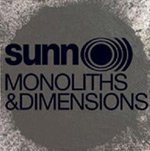Ten years on from sunn 0)))’s first recorded output, The Grimmrobe Demos, the group's patented style of supersonic slurry has transmuted and transmogrified into a new oozing beast, which despite having the same genetic makeup, has modified its DNA and absorbed any unsuspecting musical modalities it’s found useful. Monoliths & Dimensions, their seventh studio album, sees an amalgamation of the plate tectonics of drone metal with the inner and outer worlds explored in the free jazz of the 1970s, while also exhibiting a bent towards modern minimalism and classical music of the 20th century and earlier. As a whole, Monoliths ends up standing tall not only as a watershed moment in metal, but also as a 21st-century artistic statement in general. And it may just be sunn 0))))’s strongest album to date.
More than just a crossover record, Monoliths shows Greg Anderson and Steven O’Malley's unrelenting desire to expand and contrast their sonic worlds. Shedding much of the collaborators from the black metal world that made Black One so impenetrably dark (save for Mayhem vocalist Attila Csihar, who along with Oren Ambarchi have become the band's most frequent collaborators), it would seem like sunn 0))) (this is Anderson's preferred spelling, by the way) is finally allowing cracks of light to seep into their previous cloak of night. Where Black One boasted the assistance of Malefic from Xasthur, Monoliths features Julian Priester (formerly of the Sun Ra Arkestra and one of John Coltrane‘s groups), finally foregrounding sunn 0)))’s longstanding appreciation of jazz musically instead of only in spirit. And while Black One utilized the demented sensibilities of Leviathan and Lurker of Challice front man Wrest, Monoliths enlists the help of Stuart Dempster, a longtime constituent of Pauline Oliveros’ Deep Listening Band. The inclusion of American composer Eyvind Kang is yet another integral addition, taking sunn 0)))’s avant appreciation of space and time to completely new levels of heart-stopping preciseness.
Represented once again from the world of noise and sound experimentation, the aforementioned Australian guitar and effects wiz Oren Ambarchi is back playing a major role in shaping the massively undulating timbres of sunn 0)))’s opaque soundscapes. On this album, he applies his homemade oscillators to "Aghartha," devilish guitar drones on "Big Church," and gets his motorized cymbals buzzing on "Alice." Also from the world of noise is Portland mainstay Daniel Menche, who on "Hunting and Gathering" participates in a male chorus of grunts led by Thrones/Melvins madman Joe Preston. Perhaps it is due to the monochromatic nature of The Grimmrobes Demos that sunn 0))) acted early on their lust for collaboration, realizing that their growth would be contingent on melding their own sensibilities with those of other like-minded deviants, as that indeed is what turned out to be the case.
This is evident on "Aghartha" (whose title comes from the name of a folkloric city existing in the core of a hollow Earth -- C.H.U.D.’s anyone?), which starts the album in classic sunn 0))) fashion: Anderson and O’Malley's guitars slowly flutter like a thunderbird cresting a weather-beaten cliff in super slow motion. But soon, almost imperceptibly, "Aghartha" begins to conjure up elements of the natural earth, wisps of wind and the echoing of canyons. As Priester and Dempster blow away on their conch shell and Dung Cheng, respectively, Attila’s vocals boom creepily into the mix, the ritualistic resonance of his voice matching in eye-shaking reverberation the rumble of Anderson and O’Malley's guitars. Thunderous resonant sounds call from beyond the depths before a group of creaking upright basses eke out of the speakers like an ancient house full of rusty doors, all inspired by the French acousmatic composer Iancu Dumitrescu. The track recedes to "Attila," culminating his esoteric tale of inner Earth to the sounds of the tide crashing upon some invisible shore and finally dissipating into a single ghastly breath.
"Big Church" (whose freakishly long subtitle is a Hungarian word referring to a Medieval church and legal judgment stripping a person of their sacredness) revolves around an angelic female Viennese choir led by Jessika Kenney, the siren who was first made known to the metal world on Two Hunters, the operatic black opus from Portland organic farmers Wolves in the Throne Room. But before you can accuse sunn 0))) of exposing their feminine side, a manly four-guitar assault from the quartet of Ambarchi, Anderson, O’Malley and Earth guitarist/sunn 0))) raison d’etre Dylan Carlson bludgeons you back to sense. As the teeming group of musicians congeals its sacrosanct hymns into a bracing moment of tense beauty, a solitary bell rings out, bringing the world to a sudden halt.
Closer "Alice" is a nod to Alice Coltrane and her ideas regarding Universal Consciousness and mankind’s inherent oneness; it's undoubtedly sunn 0)))’s most redemptive and uplifting work. Like Earth’s 2008 gospel album, The Bees Made Honey in the Lion‘s Skull, it seems to have brought a band who had so long mired itself in total darkness into the cleansing light of day, and in both cases, the results are awe-inspiring. The reason for sunn 0)))’s sudden change in mood is up for debate, though the band attributes it simply as emerging from a darker psychology. With Anderson becoming a father and O’Malley carving out a comfortable Parisian existence, not to mention the widespread success of sunn 0))), it stands to reason that the cracking of smiles seen on Monoliths & Dimensions is simply due to the fact that these guys just aren’t as bummed out as they used to be.
1. Aghartha
2. Big Church (Megszentségteleníthetetlenségeskedéseitekért)
3. Hunting & Gathering (Cydonia)
4. Alice
More about: Sunn O)))




